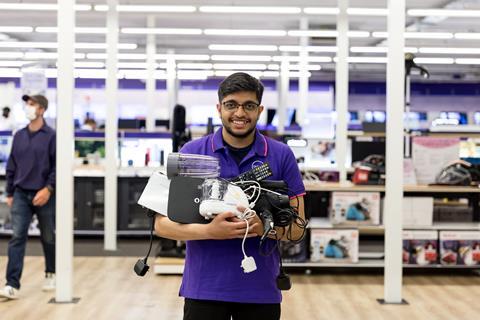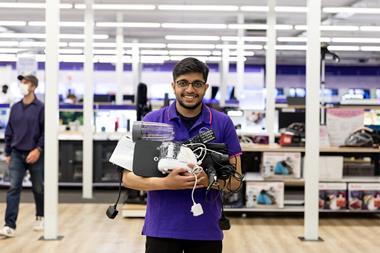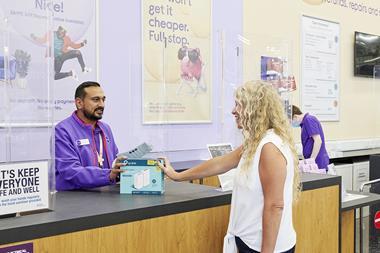Interest in secondhand products is at an all-time high, with preloved fashion, furniture and books currently all the rage, but is the same true for technology?
Despite refurbished electronics not yet reaching the same heights as secondhand fashion, there is still a growing interest as savvy consumers look for ways to be sustainable and save money in a cost-of-living crisis.
Refurbished mobile phones are perhaps the most popular, with research from tech analyst firm CCS Insight showing sales of used mobile devices generated $13.3bn (£10.5bn) in global revenue in the first quarter of 2023.
CCS Insight chief analyst Ben Wood says UK consumers are both hanging on to their phones for longer and are more willing to repair them than they were in the past.
“On average, people in the UK are keeping their phones for about four years, which is up from around two years a decade ago,” he says.
“We found 69% of UK phone owners intend to use their device for as long as they’re functional and 73% would be interested in having their devices repaired outside of the warranty period if it was at a reasonable price.”
But is the rise of refurbished electronics attributable to consumers having little choice in the cost-of-living crisis? Or will this become the future for how we buy tech?
Affordability is key
There is no doubt that consumers have recently been tightening their purse strings and the electricals sector has suffered for it, with profits at retail giants such as AO and Currys on the decline.
However, while more traditional sales channels have been on the downturn, Currys has seen an increase in customer demand for secondhand devices.
The retailer’s operations director Steve Pendleton says it sold out “80% of product lines within a week” and shifted “over 7,350 items”.
He says the refurbished lines have “really resonated with younger customers” in particular as they offer high-quality tech that would have been unaffordable if bought new.

In the ongoing cost-of-living crisis, refurbished may be the only option for cash-strapped consumers as mobile phones and laptops become increasingly essential, both in work and outside it.
Wood compares a mobile phone to a washing machine in the sense that they are both “something you can’t live without” and are often bought as distressed purchases.
“People used to buy mobile phones regularly, as every couple of years you’d upgrade and get a better camera, more capability and a bigger memory,” he says.
“This has changed and the driver towards secondhand is affordability.”
The novelty of brand-new devices seems to be wearing off as newer models have fewer feature enhancements and less innovation, while still being priced at a higher end.
It’s a case of value for money as many consumers are choosing to go for an older model if it means it is cheaper and provides a good warranty.
This is why Music Magpie group chief commercial officer Jon Miller believes more people are considering buying refurbished tech.
“If you buy a quality secondhand version of an iPhone 13, you’re probably going to pay about 20% to 25% less compared with a new one,” he says.
This trend can be seen across the globe, with CCS Insight research showing sales of secondhand smartphones grew 14% year on year in the first quarter of 2023, while sales of brand-new devices slipped 2%.
The future is refurbished
While mobile phones are proving the most popular in purchases of refurbished electronics, Wood thinks there will soon be a booming market for secondhand smartwatches, games consoles and tablets.
Music Magpie is one of the retailers thinking about this, with Miller noting an opportunity there.
“We buy certain elements of audio now: Beats headphones, gaming headsets, as well as accessories such as pencils, keyboards and mouses,” he says.
“We’re trying to work out what people prefer and give customers a choice about what they can recycle and reuse.”

Music Magpie, along with other retailers such as Currys, AO and eBay, have all been encouraging the value and sustainability of secondhand electronics, while newer players like Back Market have emerged for the sole purpose of providing refurbished products for customers.
Pendleton says he expects there to be a “long-term shift” to secondhand electronics as there is a “pressing need to address e-waste”.
He says Currys is exploring further solutions to support customers who are interested in refurbished tech, with every item sold coming with a 12-month technical guarantee.
With mainstream retailers investing in and promoting secondhand electronics, it seems this may not be a fleeting trend.
However, new devices are still being mass-produced and we are seeing growth in advanced tech such as VR headsets and Apple watches.
IDC Europe vice-president of data and analytics Francisco Jeronimo says the percentage of refurbished devices sold is still small compared with brand-new devices, but this is changing.
“We will continue to see the [new device] market growing, but not at the same pace as the refurbished market will,” he says.
“Manufacturers will launch fewer products that last longer, with the aim to refurbish them and give them a second or third life.
“For the manufacturer and the channel, this is good for business as they are selling the same device two or three times in the lifecycle – which gives them more margin than a new device.”
With affordability, sustainability and promotion from retailers driving interest in refurbished tech, this channel is becoming increasingly important for electricals retailers.
But with newer, more innovative tech constantly emerging, it may be a while before we see secondhand tech become the number one choice for consumers.


























No comments yet